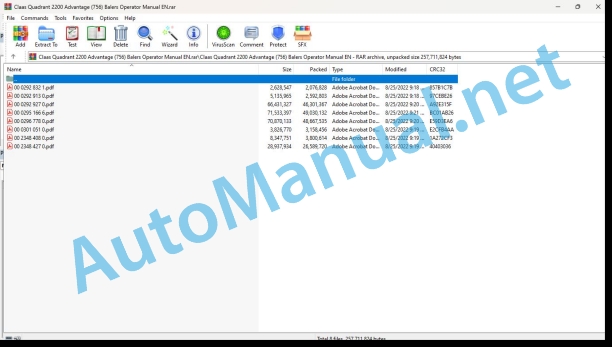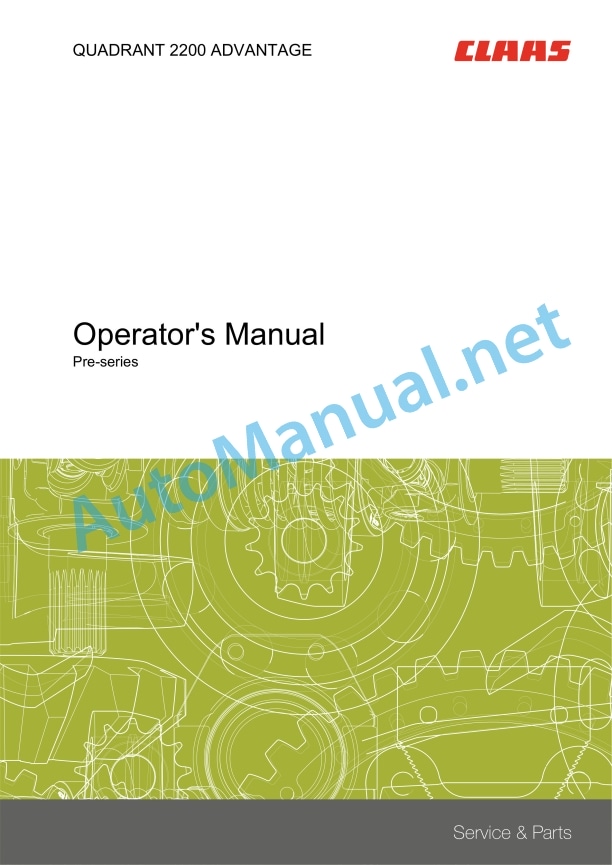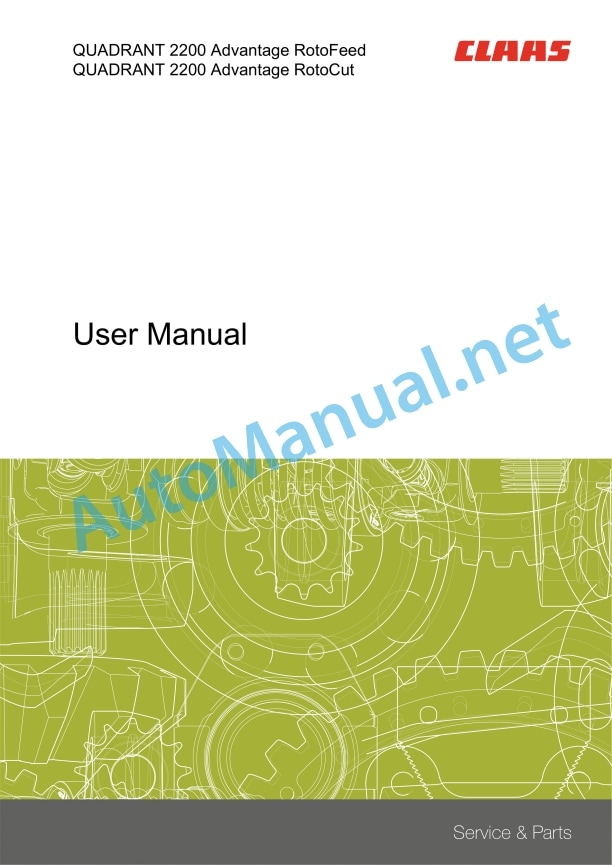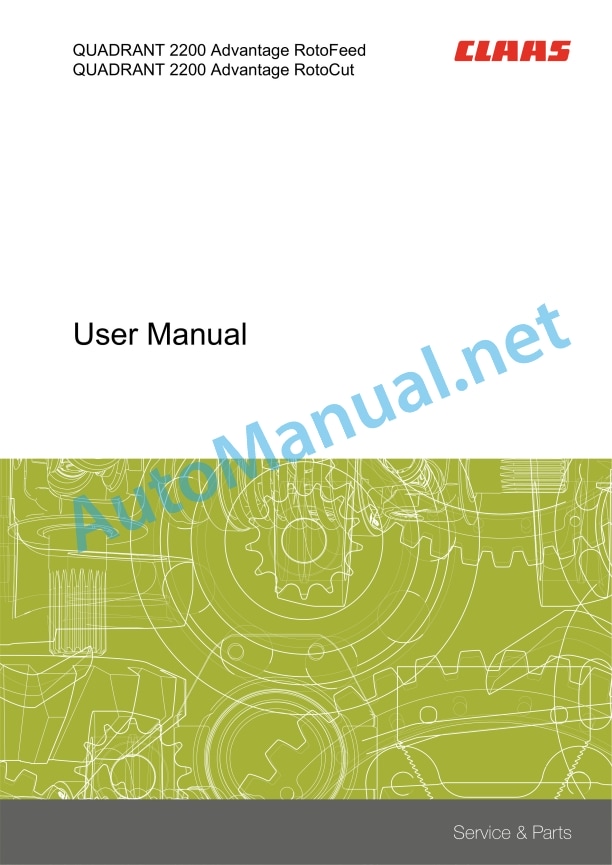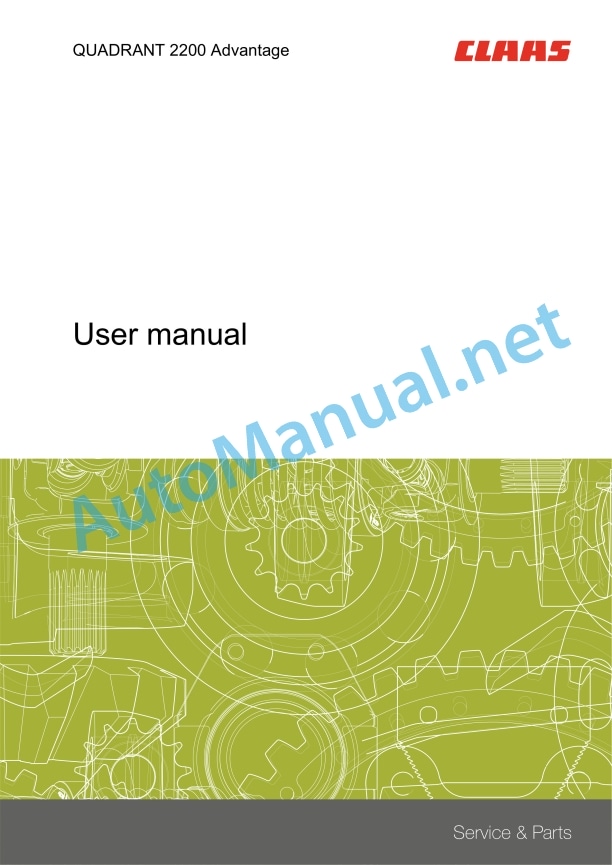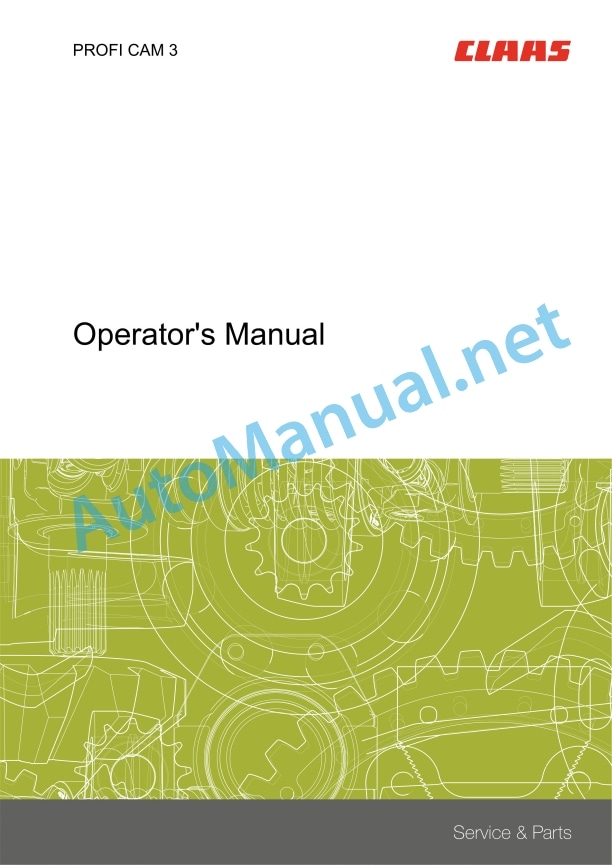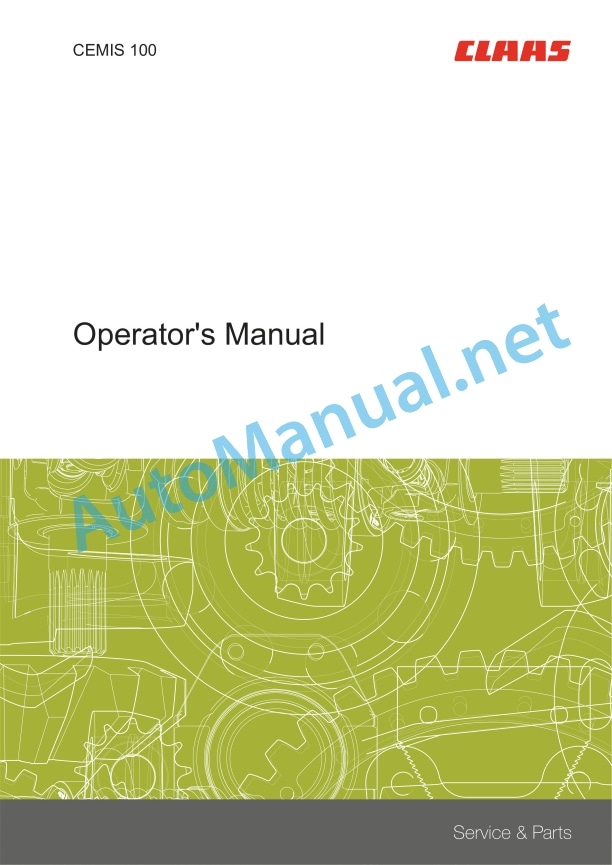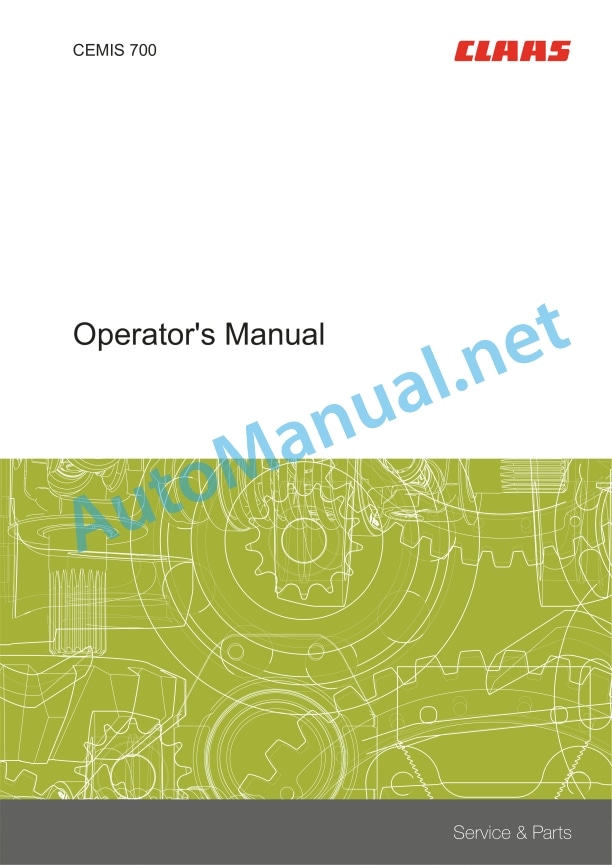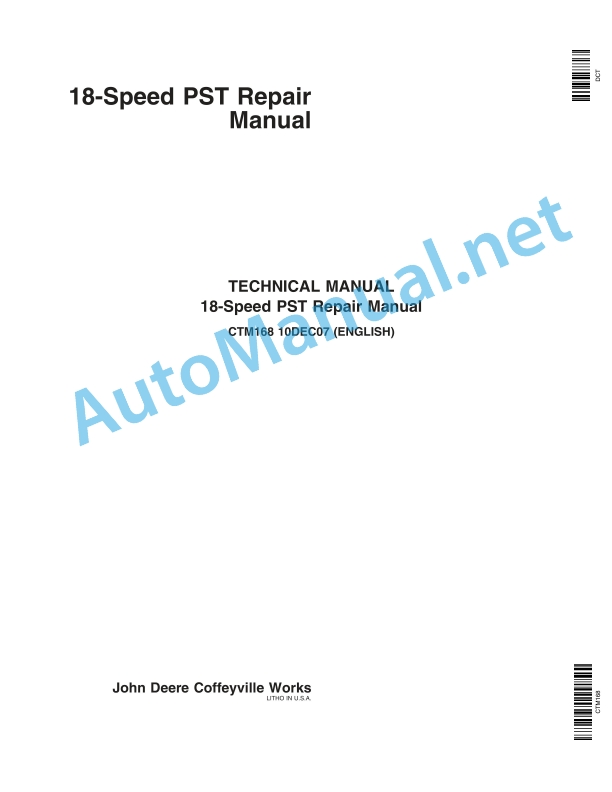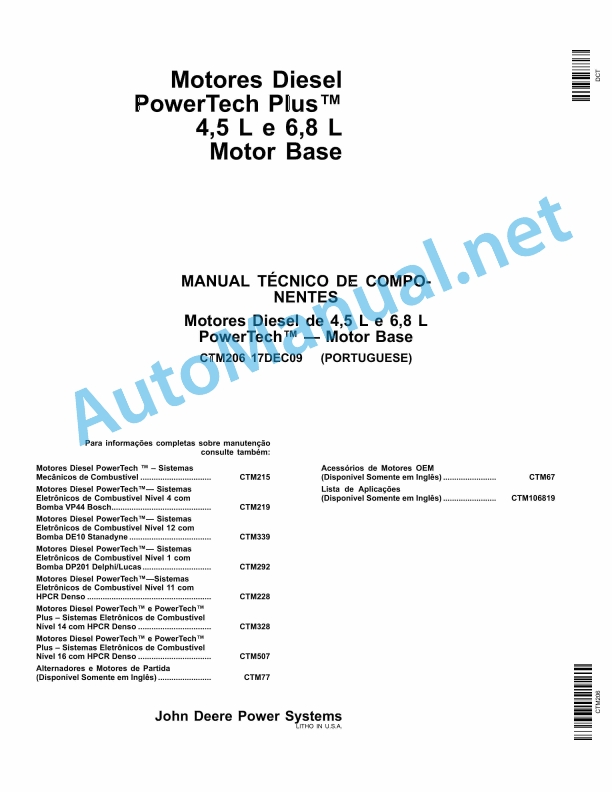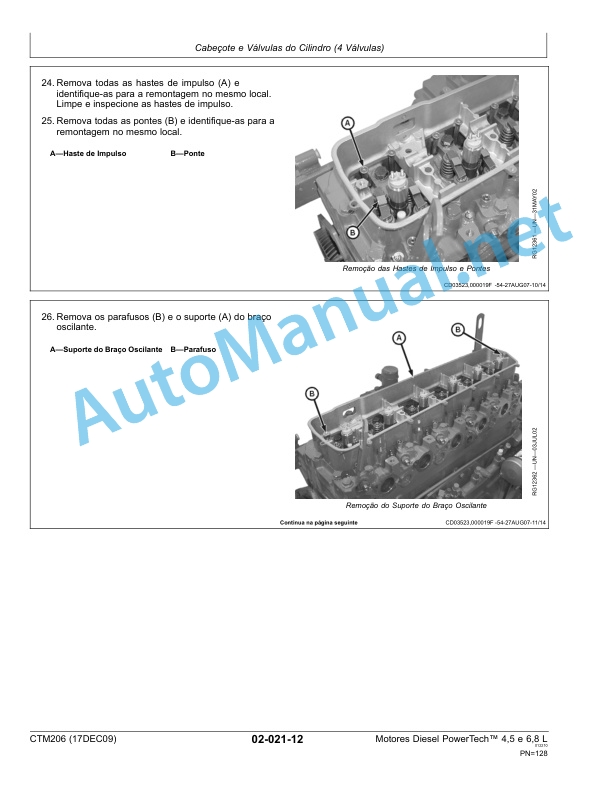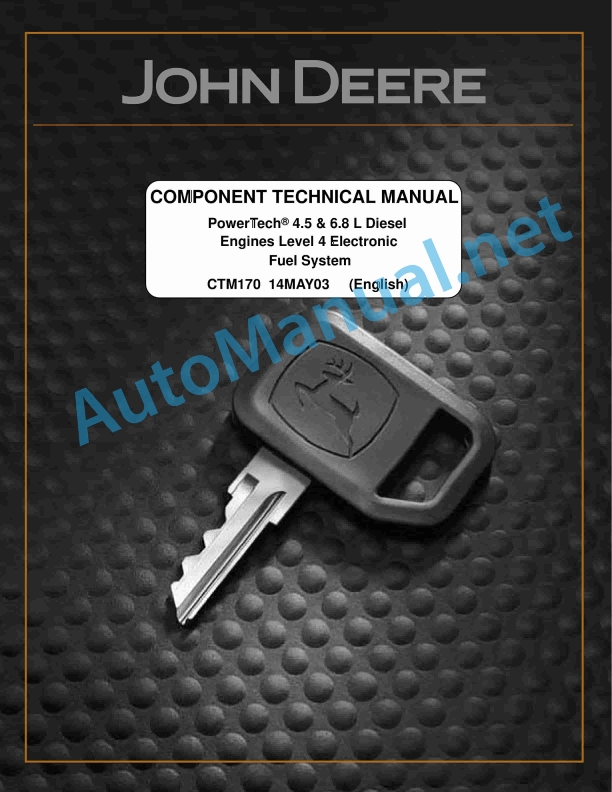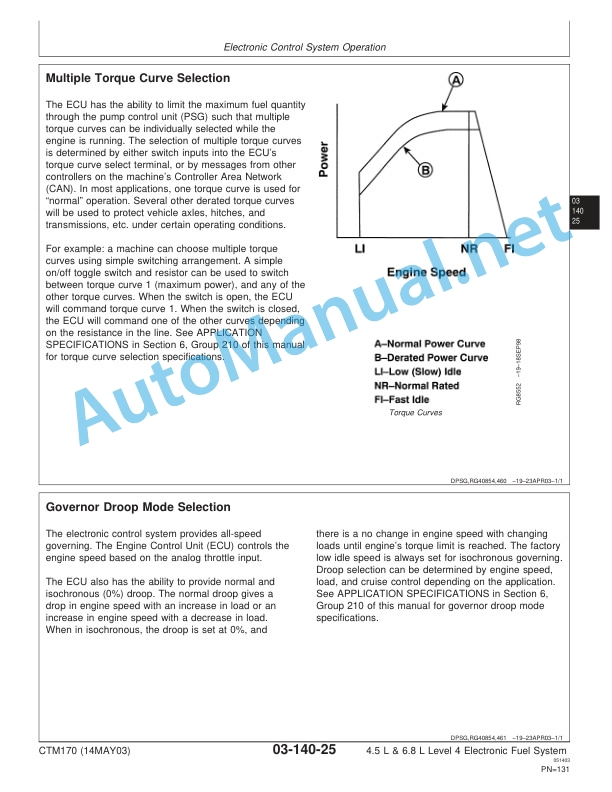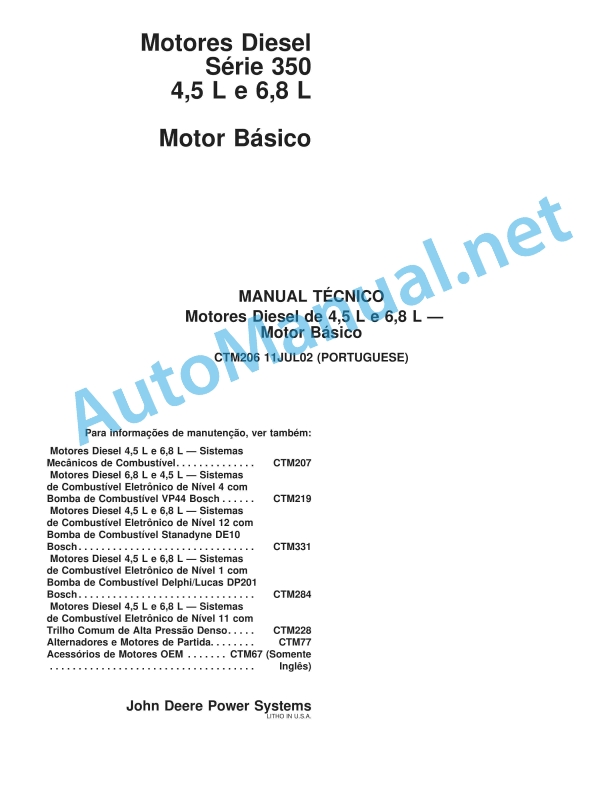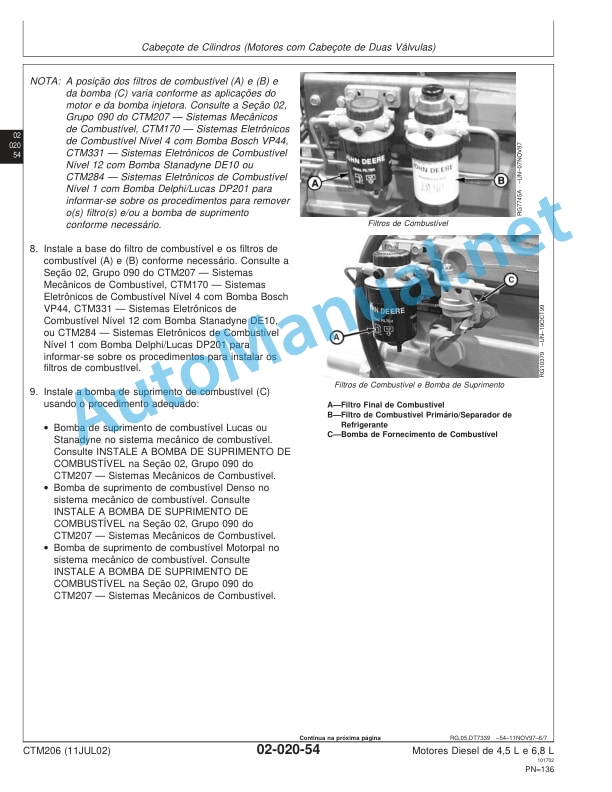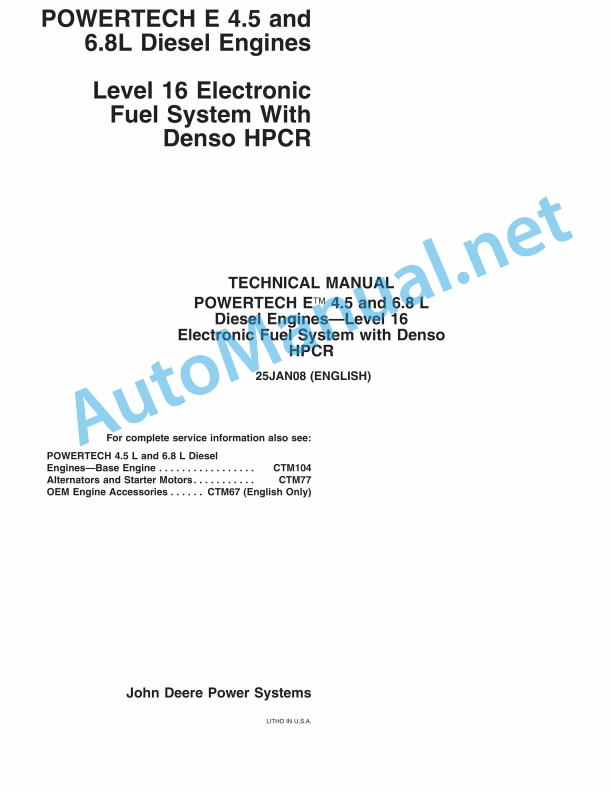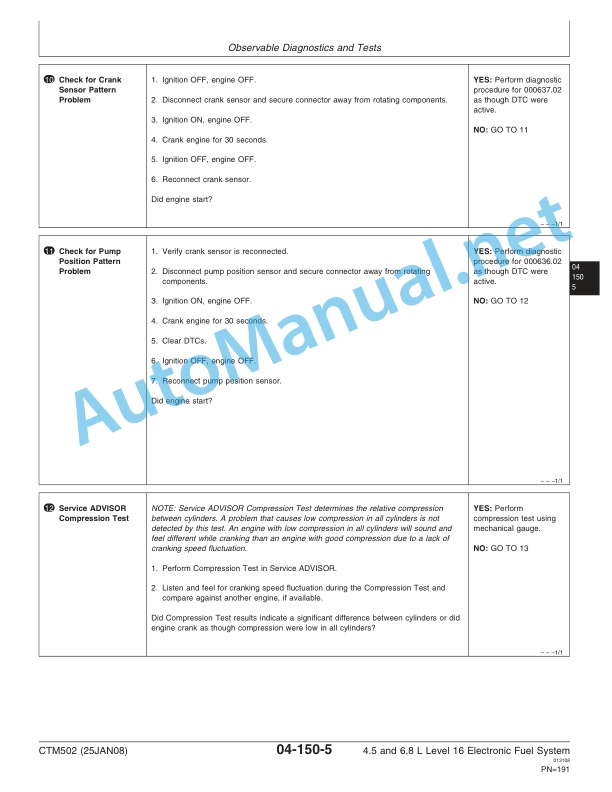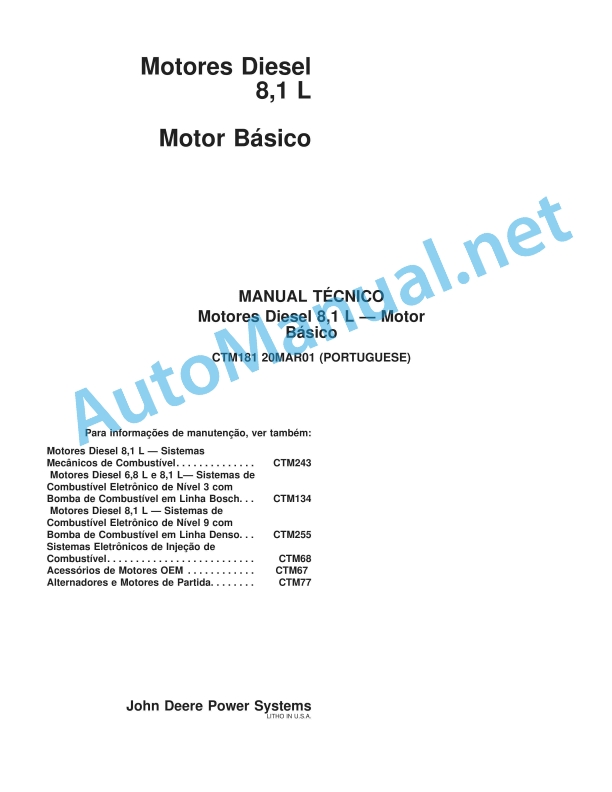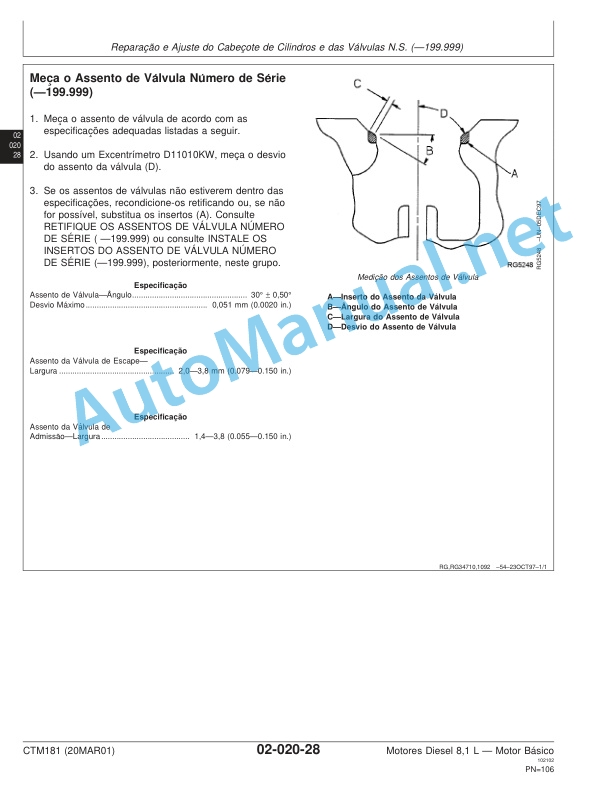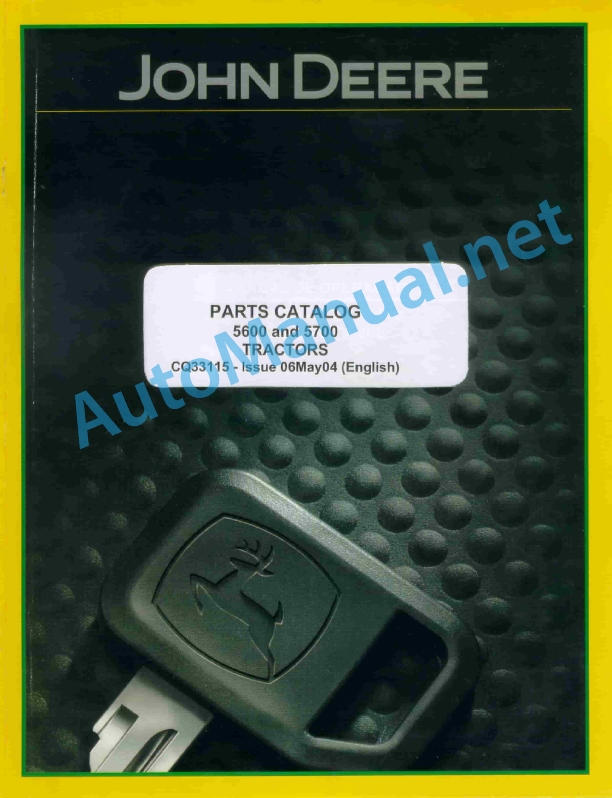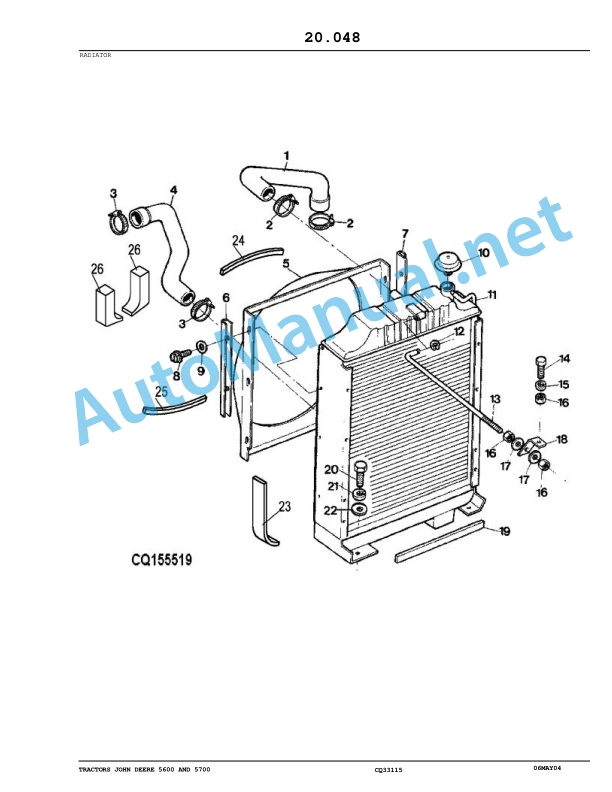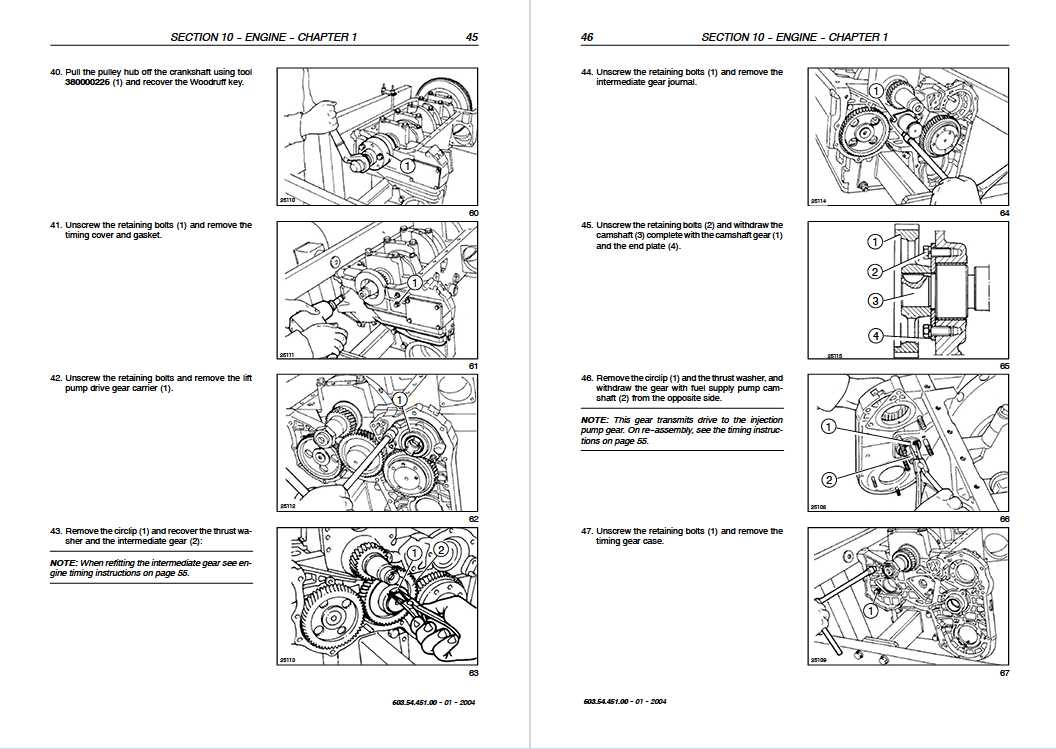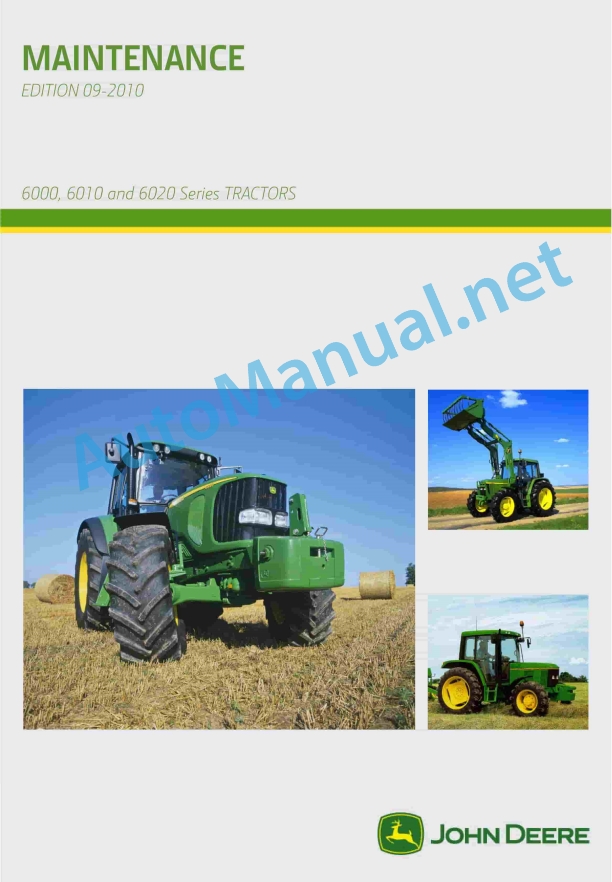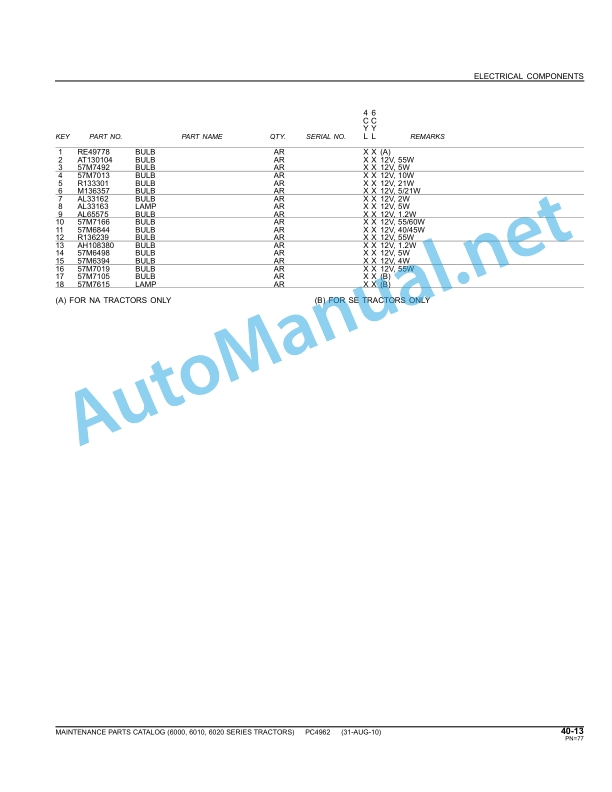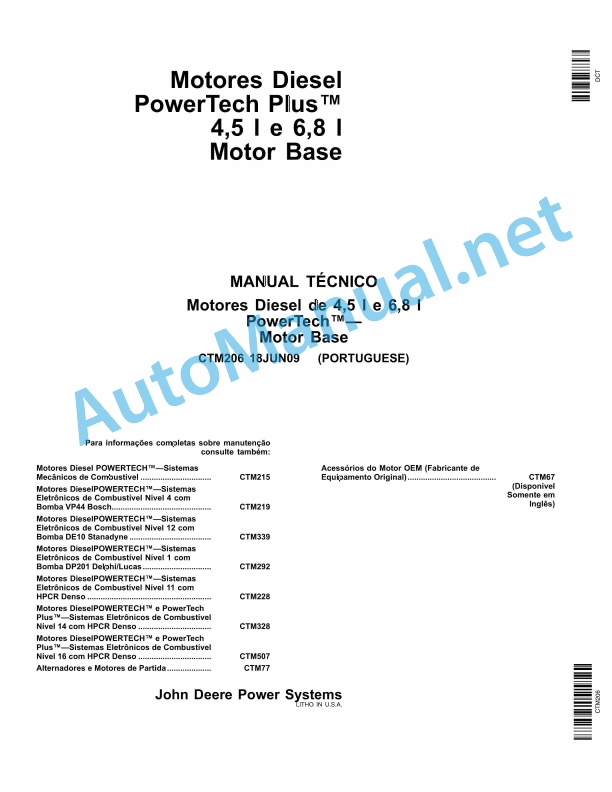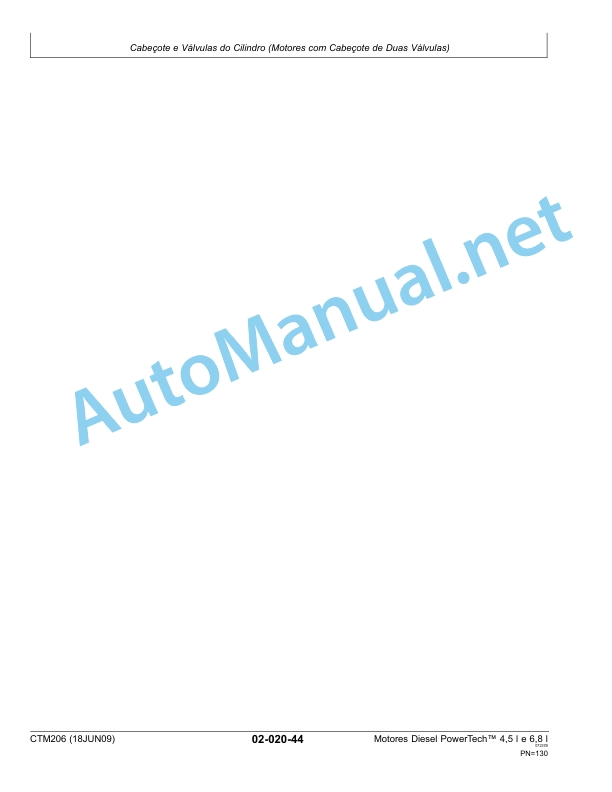Claas Quadrant 2200 Advantage (756) Balers Operator Manual EN
$50.00
- Model: Quadrant 2200 Advantage (756) Balers
- Type Of Manual: Operator Manual
- Language: EN
- Format: PDF(s)
- Size: 174 MB
File List:
00 0292 832 1.pdf
00 0292 913 0.pdf
00 0292 927 0.pdf
00 0295 166 6.pdf
00 0296 778 0.pdf
00 0301 051 0.pdf
00 2348 408 0.pdf
00 2348 427 0.pdf
00 0292 832 1.pdf:
Table of contents
1 To this Operator’s Manual
1.1 Notes on the manual
1.1.1 Validity of the manual
1.1.2 Using the manual
1.1.3 Symbols and notes
1.1.4 Technical specifications
2.1 Safety rules
2.1.1 Particularly important
2.1.2 Intended use
2.1.3 Reasonably foreseeable misuse
2.1.4 General safety and accident prevention regulations
3 Product description
3.1 Overview and method of operation
3.1.1 OPERATOR overview
3.1.2 OPERATOR mode of operation
3.2 Identification plates and identification numbers
3.2.1 Spare parts and technical questions
3.2.2 OPERATOR identification plate
4 Operating and display elements
4.1 CLAAS OPERATOR
4.1.1 Terminal
4.1.2 Terminal program
4.1.3 Menu overview
4.1.4 Information menu
4.1.5 Settings menu
4.1.6 Time menu
4.1.7 Diagnosis menu
4.1.8 Language and units menu
5 Technical specifications
5.1 CLAAS OPERATOR
5.1.1 Specification
6 Operation
6.1 Switching the OPERATOR on and off
6.1.1 Switching on the OPERATOR
6.1.2 Selecting an application
6.1.3 Switching off the OPERATOR
6.2 Terminal settings
6.2.1 Adjusting the screen and volume
Night mode
6.2.2 Adjusting the date and time
6.2.3 Displaying the diagnosis information
On-board voltage display (1)
Enabling the speed signal (2)
Displaying the CLAAS ISOBUS ECU address and name (3)
6.2.4 Setting the language and display formats
Setting the language
Setting the display formats
7 Maintenance
7.1 Maintenance
7.1.1 Daily
8 Putting out of operation and disposal
8.1 General information
8.1.1 Putting out of operation and disposal
9 Technical terms and abbreviations
9.1 Terms and explanations
9.1.1 Technical words
9.1.2 Abbreviations
00 0292 913 0.pdf:
QUADRANT 2200 ADVANTAGE
Table of contents
1 To this Operator’s Manual
1.1 General Information
1.1.1 Manual validity
2 Operating and control elements
2.1 CLAAS OPERATOR
2.1.1 Presentation
2.1.2 Screen
2.1.3 Key identification
2.1.4 Description of the CLAAS OPERATOR Use menus
2.1.5 Description of the CLAAS OPERATOR Service menus
2.2 ISOBUS terminal
2.2.1 Presentation
2.2.2 General points
3 Operation
3.1 CLAAS OPERATOR
3.1.1 Baling pressure
3.1.2 Bale length
3.1.3 Automatic lubrication
3.1.4 Counters Menu
3.1.5 Faults
3.1.6 Manually activating the tying process
3.1.7 Bale chamber filling indicator*
3.1.8 Activating / deactivating the knives (RotoCut option)
3.1.9 Cutting frame (RotoCut option)
3.1.10 Baling process
3.2 Unblocking the baler
3.2.1 Cutting rotor blockage (RotoCut option)
4 Faults and remedies
4.1 CLAAS OPERATOR
4.1.1 Faults displayed on the control terminal
4.1.2 Electric circuit
4.1.3 Power take-off fault
4.1.4 Conveying system
4.1.5 Bale ramp
4.1.6 No twine fault
4.1.7 Tying faults
00 0292 927 0.pdf:
QUADRANT 2200 Advantage RotoFeedQUADRANT 2200 Advantage RotoCut
Table of contents
1 To this operator’s manual
1.1 General Information
1.1.1 Manual validity
1.1.2 Using the manual
1.1.3 Technical specifications
2.1 General Information
2.1.1 General points
2.1.2 Using in line with intended usage
2.1.3 Reasonably foreseeable improper usage
2.1.4 Safety advice
2.1.5 Definition of hazard information
2.1.6 Driving on the road
2.1.7 Accident prevention
2.1.8 Waste disposal
2.1.9 Residual risks
2.2 Safety decals
2.2.1 Description
2.2.2 Location of safety stickers
2.3 Safety equipment
2.3.1 Indicator lights
2.3.2 Reflective equipment
2.3.3 Jack stand
2.3.4 Chocks
2.3.5 Parking brake
2.3.6 Flywheel brake
2.3.7 Locking the pick-up
2.3.8 Locking the bale ramp
3 Machine description
3.1 Existing models
3.1.1 Machine description
3.2 Overview and functions
3.2.1 Left-hand side
3.2.2 Right-hand side
3.3 Working and service areas
3.3.1 General points
3.3.2 Front section of the baler
3.3.3 Upper section of the baler
3.4 Identification plate and serial number
3.4.1 Replacement parts and technical information
3.4.2 Position of identification plates
3.4.3 Machine identification plate
3.4.4 Drawbar identification plate
3.5 General operating principle
3.5.1 Baling cycle
3.6 Transmission and drive
3.6.1 Power transmission
3.6.2 Slip clutch
3.6.3 Main drive
3.6.4 Rotor drive
3.6.5 Feed rake drive
3.6.6 Knotter drive
3.7 Crop feeding
3.7.1 Pick-up
3.7.2 Flattening rollers
3.7.3 Short crop plate
3.8 Feeder unit
3.8.1 Rotor
3.8.2 RotoCut cutting unit (optional)
3.8.3 Feed rake
3.9 Baling system
3.9.1 Piston and bale chamber
3.10 Tying system
3.10.1 Tying process
3.10.2 Twine boxes
3.10.3 Twine fault indicator
3.10.4 Needles
3.10.5 Knotters
3.10.6 Turbofan
3.11 Bale discharge
3.11.1 Control unit
3.11.2 Bale ramp
3.11.3 Bale ramp position detector (optional)
3.11.4 Bale discharge sensor (option)
3.11.5 Moisture sensor (option)
3.11.6 Bale ejector
3.12 Central lubrication
3.12.1 General points
3.12.2 Manual central lubrication
3.12.3 Automatic central lubrication
3.12.4 Extra lubrication
3.13.1 General points
3.13.2 Single axle
3.13.3 Tandem axle
3.13.4 Trailing tandem axle
3.14 Service brake
3.14.1 General points
3.14.2 Pneumatic braking
3.14.3 Hydraulic braking
3.14.4 Active hydraulic braking
3.15 Hydraulic system
3.15.1 Hydraulic oil reservoir
3.16 Equipment
3.16.1 Ladder
3.16.2 Front ladder support
3.16.3 Step
3.16.4 Electronic module
3.16.5 12 V socket
4 Operating and control elements
4.1 CLAAS OPERATOR
4.1.1 Presentation
4.1.2 Screen
4.1.3 Key identification
4.1.4 Description of the CLAAS OPERATOR Use menus
4.2 ISOBUS terminal
4.2.1 Presentation
4.2.2 General points
5 Technical specifications
5.1.1 General points
5.1.2 Dimensions
5.1.3 Weight
5.1.4 Hitching
5.1.5 Universal drive shaft
5.1.6 Feeding and baling
5.1.7 Tying device
5.1.8 Wheels
5.1.9 Hydraulic circuit
5.1.10 Bolt tightening torques
5.1.11 Braking
5.1.12 Speed – Type of brake / Axle
5.1.13 Greasing and lubrication
5.1.14 Noise level
5.2 Safety devices
5.2.1 Shear bolt
5.2.2 Overload clutch
5.3 Tractor
5.3.1 Power required
5.3.2 Power take-off
5.3.3 Hitching
5.3.4 Electrical connections
5.3.5 Hydraulic connections
5.3.6 Hydraulic oil and circuit
5.3.7 Braking
6 Machine preparation
6.1 General Information
6.1.1 Before first use
6.1.2 Checking the equipment
6.2 Universal drive shaft
6.2.1 Safety advice
6.2.2 Overlap of the universal drive shaft
6.2.3 Adapting the length of the universal drive shaft
6.2.4 Conversion – 8 splines (optional)
6.2.5 Double articulation wide angle universal drive shaft
6.2.6 Fitting the universal drive shaft
6.3 Coupling frame
6.3.1 Recommendations
6.3.2 Coupling types
6.3.3 Securing the coupling
6.3.4 Adapting jaw drawbar/swinging drawbar
6.3.5 Hitching the baler to the tractor
6.3.6 Fitting the universal drive shaft
6.4 Hydraulic connections
6.4.1 Hose identification
6.4.2 Jack stand and pick-up
6.4.3 General baler hydraulics
6.5 Electrical connections
6.5.1 Identifying the electrical cables
6.5.2 Lighting
6.5.3 Battery cable (optional)
6.5.4 Power supply for the baler and the CLAAS OPERATOR
6.5.5 Power supply for the baler using the ISOBUS cable
6.6 Service brake
6.6.1 Hydraulic brakes
6.6.2 Active hydraulic brakes
6.6.3 Pneumatic brakes
6.7.1 Twine quality
6.7.2 Preparation
6.7.3 Adjusting the twine tensioner
6.7.4 Fitting the twine
6.7.5 Fitting the twine in the knotters
Activating manual tying
Baler fitted with mechanical tying activation
Baler fitted with electrical tying activation
6.7.6 Checking the settings
6.8 Cutting unit
6.8.1 Safety advice
6.8.2 Checking
6.8.3 Fitting the knives
6.8.4 Fitting the dummy knives (optional)
6.8.5 Unused knives and dummy knives
6.9 Loading the machine
6.9.1 Raising the baler
6.9.2 Lashing the baler
7 Operation
7.1 General Information
7.1.1 Baler user
7.1.2 Opening the doors and housings
7.2 Travelling with the baler
7.2.1 Checking the equipment
7.2.2 Preparing for transportation
7.2.3 Travelling on the road
7.2.4 Arriving at the field
7.2.5 Driving in fields
7.2.6 Parking
7.3 Before each usage
7.3.1 Reminders
7.3.2 Universal drive shaft
7.3.3 Baler maintenance
7.4 Commissioning in the field
7.4.1 User advice
7.4.2 Starting the machine
Universal drive shaft
Crop conveying system
After a machine stoppage
7.4.3 Bale ramp
Manual bale ramp
Hydraulic bale ramp
7.4.4 Bale ejector (optional)
7.4.5 Trailing axle (optional)
7.5 Pick-up
7.5.1 Important
7.5.2 Pivoting pick-up wheels
7.5.3 Folding pick-up wheels
7.5.4 Pick-up height
7.5.5 Flattening rollers
7.6 Cutting unit
7.6.1 RotoCut cutting unit (optional)
7.7 Bale parameters
7.7.1 Baler settings
Bale length setting
Baler fitted with mechanical tying activation
Baler fitted with electrical tying activation
7.8 CLAAS OPERATOR
7.8.1 Baling pressure
7.8.2 Bale length
7.8.3 Automatic lubrication
7.8.4 Counters Menu
7.8.5 Faults
7.8.6 Manually activating the tying process
7.8.7 Bale chamber filling indicator*
7.8.8 Activating / deactivating the knives (RotoCut option)
7.8.9 Cutting frame (RotoCut option)
7.8.10 Baling process
7.9 Unblocking the baler
7.9.1 How can blockages be avoided?
7.9.2 Safety advice
7.9.3 Pick-up blockage
7.9.4 Blockage in the flattening rollers
7.9.5 Blockage of the feed rotor (RotoFeed option)
Unblocking the rotor
7.9.6 Cutting rotor blockage (RotoCut option)
7.10 After use
7.10.1 Reminders
7.10.2 Securing the baler
7.10.3 Unhitching the baler
7.10.4 Daily checks
7.10.5 Daily cleaning
8 Faults and remedies
8.1.1 Causes of tying faults
8.1.2 Solutions of tying faults
8.2 Central lubrication
8.2.1 Solutions for central lubrication faults
8.3 CLAAS OPERATOR
8.3.1 Faults displayed on the control terminal
8.3.2 Electric circuit
8.3.3 Power take-off fault
8.3.4 Conveying system
8.3.5 Bale ramp
8.3.6 No twine fault
8.3.7 Tying faults
8.4 Electrical / Electronic equipment
8.4.1 Electrical circuit faults
9 Maintenance
9.1 General maintenance Information
9.1.1 Maintenance and safety advice
9.1.2 Wheels and tyres
9.1.3 Brakes
9.1.4 Hydraulic circuit
9.1.5 Chains
9.1.6 Baling and tying device
9.1.7 Universal drive shaft
9.1.8 Hitching
9.1.9 Cutting unit
9.1.10 Safety devices
9.1.11 Bolts and nuts
9.1.12 Lubrication and greasing
9.1.13 Inductive sensors
9.1.14 Welding work
9.1.15 Replacement parts
9.2 Lubricants charts
9.2.1 Lubricants
9.3 Maintenance schedules
9.3.1 Maintenance operations before gathering crop
9.3.2 Maintenance operations after the first 10 hours of operation
9.3.3 Maintenance operations after the first 50 hours of operation
9.3.4 Maintenance operations after the first 100 hours of operation
9.3.5 Maintenance operations after the first 250 hours of operation
9.3.6 Maintenance operations every 5 hours of operation or every day
9.3.7 Maintenance operations every 10 hours of operation or every day
9.3.8 Maintenance operations every 50 hours of operation
9.3.9 Maintenance operations every 100 hours of operation
9.3.10 Maintenance operations every 250 hours of operation
9.3.11 Maintenance operations every 15,000 bales
9.3.12 Annual maintenance operations or every 500 hours of operation
9.3.13 Maintenance operations if necessary
9.4 Basic settings
9.4.1 Basic calibration of the baler
9.4.2 Counter-knives
Setting the counter-knives
9.5 Maintenance operations gearbox
9.5.1 Main drive gearbox
9.5.2 Main drive gearbox mounting
9.5.3 Elastomer buffer stops
9.5.4 Drawbar angle drive gearbox
9.5.5 Feed rake drive gearbox
9.5.6 Rotor upper angle drive
9.5.7 Rotor and pick-up drive gearbox
9.5.8 Knotter drive gearbox
9.5.9 Flywheel brake
9.6 Maintenance operations clutch
9.6.1 Overrunning slip clutch
9.6.2 Main drive shear bolt
9.7 Maintenance operations axle and wheels
9.7.1 Single axle
9.7.2 Tandem axle
9.7.3 Trailing tandem axle
9.7.4 Checking wheel tightness
9.7.5 Wheel changing
9.7.6 Wheel hub
9.7.7 Checking the tyres
9.8 Maintenance operations brake
9.8.1 Hydraulic and active hydraulic brakes
9.8.2 Pneumatic brakes
9.8.3 Replacing the brake pads
9.9 Maintenance operations hydraulic system
9.9.1 Hydraulic reservoir
9.9.2 Hydraulic pressure accumulator
9.10 Maintenance operations pick-up
9.10.1 Pick-up with double feed auger (depending on equipment)
9.10.2 Pick-up with full length auger (depending on equipment)
9.11 Maintenance operations tying
9.11.1 Manually starting tying
9.11.2 Needles
Needle height
Needle top dead centre:
Needles – piston position:
Check the position of the needles/piston
Alter the position of the knotter drive gearbox
Alter the position of the universal drive shaft
Checking the piston safety synchronisation
Cleat setting (12)
Replacing a needle
Needle brake:
9.11.3 Changing the needle brake pads
Removing a needle brake
Disassembling a needle brake
Assembling a needle brake
Fitting a needle brake
9.11.4 Adjusting the twine tensioner
9.11.5 Knotter settings
9.11.6 Tying release device
9.11.7 Knotter drive shaft shear bolt
9.11.8 Changing the knotter brake pads
Removing the knotter brake
Disassembling the knotter brake
Assembling the knotter brake
9.12 Maintenance operations hitch
9.12.1 Check the hitch coupling mounting
9.12.2 Checking the drawbar head mounting
9.13 Maintenance operations central lubrication system
9.13.1 Manual central lubrication (optional)
9.13.2 Automatic central lubrication (optional)
9.14 Lubrication chart
9.14.1 Lubrication intervals
9.14.2 Universal drive shaft
9.14.3 Lubrication points – 5 h
9.14.4 Lubrication points – 10 h
9.14.5 Lubrication points – 50 h
9.14.6 Lubrication points – 100 h
9.14.7 Lubrication points – 250 hrs
9.15 Winter storage
9.15.1 General points
9.15.2 Cleaning
9.15.3 Lubricating
9.15.4 Maintenance
9.15.5 Storage
10 Placing out of operation and disposal
10.1 General Information
10.1.1 Putting out of operation and disposal
11 EC-declaration of conformity
11.1 General Information
11.1.1 Declaration of Conformity for EC
00 0295 166 6.pdf:
QUADRANT 2200 Advantage RotoFeedQUADRANT 2200 Advantage RotoCut
Table of contents
1 To this Operator’s Manual
1.1 General Information
1.1.1 Manual validity
1.1.2 Using the manual
1.1.3 Technical specifications
2.1 General Information
2.1.1 General points
2.1.2 Using in line with intended usage
2.1.3 Reasonably foreseeable improper usage
2.1.4 Safety advice
2.1.5 Definition of hazard information
2.1.6 Driving on the road
2.1.7 Accident prevention
2.1.8 Waste disposal
2.1.9 Residual risks
2.2 Safety decals
2.2.1 Description
2.2.2 Location of safety stickers
2.3 Safety equipment
2.3.1 Indicator lights
2.3.2 Reflective equipment
2.3.3 Jack stand
2.3.4 Chocks
2.3.5 Parking brake
2.3.6 Flywheel brake
2.3.7 Locking the pick-up
2.3.8 Locking the bale ramp
3 Machine description
3.1 Existing models
3.1.1 Machine description
3.2 Overview and functions
3.2.1 Left-hand side
3.2.2 Right-hand side
3.3 Working and service areas
3.3.1 General points
3.3.2 Front section of the baler
3.3.3 Upper section of the baler
3.4 Identification plate and serial number
3.4.1 Replacement parts and technical information
3.4.2 Position of identification plates
3.4.3 Machine identification plate
3.4.4 Drawbar identification plate
3.5 General operating principle
3.5.1 Baling cycle
3.6 Control terminal
3.6.1 Control terminal
3.6.2 ISOBUS connection
3.7 Transmission and drive
3.7.1 Power transmission
3.7.2 Slip clutch
3.7.3 Main drive
3.7.4 Rotor drive
3.7.5 Feed rake drive
3.7.6 Knotter drive
3.8 Crop feeding
3.8.1 Pick-up
3.8.2 Flattening rollers
3.8.3 Short crop plate
3.9 Feeder unit
3.9.1 Rotor
3.9.2 RotoCut cutting unit (optional)
3.9.3 Feed rake
3.10 Baling system
3.10.1 Piston and bale chamber
3.11 Tying system
3.11.1 Tying process
3.11.2 Twine boxes
3.11.3 No twine warning
3.11.4 Needles
3.11.5 Knotters
3.11.6 Turbofan
3.12 Bale discharge
3.12.1 Control unit
3.12.2 Bale ramp
3.12.3 Bale ramp position detector (optional)
3.12.4 Bale discharge sensor (option)
3.12.5 Moisture sensor (option)
3.12.6 Bale ejector
3.13 Central lubrication
3.13.1 General points
3.13.2 Manual central lubrication
3.13.3 Automatic central lubrication
3.13.4 Extra lubrication
3.14.1 General points
3.14.2 Single axle
3.14.3 Tandem axle
3.14.4 Trailing tandem axle
3.15 Service brake
3.15.1 General points
3.15.2 Pneumatic braking
3.15.3 Hydraulic braking
3.15.4 Active hydraulic braking
3.16 Hydraulic system
3.16.1 Hydraulic oil reservoir
3.17 Equipment
3.17.1 Ladder
3.17.2 Front ladder support
3.17.3 Step
3.17.4 Electronic module
3.17.5 12 V socket
4 Operating and control elements
4.1 CLAAS Medium Terminal
4.1.1 Presentation
4.1.2 Screen
4.1.3 Key identification
4.1.4 Home page
4.1.5 Description of the menus
4.2 ISOBUS terminal
4.2.1 Presentation
4.2.2 General points
4.2.3 Screen
4.2.4 Description of the ISOBUS terminal Use menus
5 Technical specifications
5.1.1 General points
5.1.2 Dimensions
5.1.3 Weight
5.1.4 Hitching
5.1.5 Universal drive shaft
5.1.6 Feeding and baling
5.1.7 Tying device
5.1.8 Wheels
5.1.9 Hydraulic circuit
5.1.10 Bolt tightening torques
5.1.11 Braking
5.1.12 Speed – Type of brake / Axle
5.1.13 Greasing and lubrication
5.1.14 Noise level
5.2 Safety devices
5.2.1 Shear bolt
5.2.2 Overload clutch
5.3 Tractor
5.3.1 Power required
5.3.2 Power take-off
5.3.3 Hitching
5.3.4 Electrical connections
5.3.5 Hydraulic connections
5.3.6 Hydraulic oil and circuit
5.3.7 Braking
6 Machine preparation
6.1 General Information
6.1.1 Before first use
6.1.2 Checking the equipment
6.2 Universal drive shaft
6.2.1 Safety advice
6.2.2 Overlap of the universal drive shaft
6.2.3 Adapting the length of the universal drive shaft
6.2.4 Conversion – 8 splines (optional)
6.2.5 Double articulation wide angle universal drive shaft
6.2.6 Fitting the universal drive shaft
6.3 Coupling frame
6.3.1 Recommendations
6.3.2 Coupling types
6.3.3 Securing the coupling
6.3.4 Adapting jaw drawbar/swinging drawbar
6.3.5 Hitching the baler to the tractor
6.3.6 Fitting the universal drive shaft
6.4 Hydraulic connections
6.4.1 Hose identification
6.4.2 Jack stand and pick-up
6.4.3 General baler hydraulics
6.5 Electrical connections
6.5.1 Identifying the electrical cables
6.5.2 Lighting
6.5.3 Battery cable (optional)
6.5.4 Electrical supply for the baler and the CLAAS Medium Terminal
6.5.5 Power supply for the baler using the ISOBUS cable
6.6 Service brake
6.6.1 Hydraulic brakes
6.6.2 Active hydraulic brakes
6.6.3 Pneumatic brakes
6.7.1 Twine quality
6.7.2 Preparation
6.7.3 Adjusting the twine tensioner
6.7.4 Fitting the twine
6.7.5 Fitting the twine in the knotters
Activating manual tying
Baler fitted with mechanical tying activation
Baler fitted with electrical tying activation
6.7.6 Checking the settings
6.8 Cutting unit
6.8.1 Safety advice
6.8.2 Checking
6.8.3 Fitting the knives
6.8.4 Fitting the dummy knives (optional)
6.8.5 Unused knives and dummy knives
6.9 Loading the machine
6.9.1 Raising the baler
6.9.2 Lashing the baler
7 Operation
7.1 General Information
7.1.1 Baler user
7.1.2 Opening the doors and housings
7.2 Travelling with the baler
7.2.1 Checking the equipment
7.2.2 Preparing for transportation
7.2.3 Travelling on the road
7.2.4 Arriving at the field
7.2.5 Driving in fields
7.2.6 Parking
7.3 Before each usage
7.3.1 Reminders
7.3.2 Universal drive shaft
7.3.3 Baler maintenance
7.4 Commissioning in the field
7.4.1 User advice
7.4.2 Starting the machine
Universal drive shaft
Crop conveying system
After a machine stoppage
7.4.3 Bale ramp
Manual bale ramp
Hydraulic bale ramp
7.4.4 Bale ejector (optional)
7.4.5 Trailing axle (optional)
7.5 Pick-up
7.5.1 Important
7.5.2 Pick-up wheels
7.5.3 Pick-up height
7.5.4 Flattening rollers
7.6 Cutting unit
7.6.1 RotoCut cutting unit (optional)
7.7 Bale parameters
7.7.1 Baler settings
Bale length setting
Baler fitted with mechanical tying activation
Baler fitted with electrical tying activation
7.8 CLAAS Medium Terminal
7.8.1 Baling pressure (RotoCut option)
7.8.2 Activating / deactivating the knives (RotoCut option)
7.8.3 Cutting frame (RotoCut option)
7.8.4 Counters menu (RotoCut option)
7.8.5 Faults
7.8.6 Baling process
7.8.7 Manually activating the tying process (optional)
7.8.8 Automatic lubrication (depending on equipment)
7.8.9 Bale length setting
7.8.10 Sound
7.9 ISOBUS terminal
7.9.1 Baling pressure (RotoCut option)
7.9.2 Activating / deactivating the knives (RotoCut option)
7.9.3 Cutting frame (RotoCut option)
7.9.4 Counters Menu
Resetting the maintenance indicator
7.9.5 Faults
7.9.6 Baling process
7.9.7 Manually activating the tying process (optional)
7.9.8 Automatic lubrication
7.9.9 Bale length setting
7.10 Unblocking the baler
7.10.1 How can blockages be avoided?
7.10.2 Safety advice
7.10.3 Pick-up blockage
7.10.4 Blockage in the flattening rollers
7.10.5 Blockage of the feed rotor (RotoFeed option)
Unblocking the rotor
7.10.6 Cutting rotor blockage (RotoCut option)
7.11 After use
7.11.1 Reminders
7.11.2 Securing the baler
7.11.3 Unhitching the baler
7.11.4 Daily checks
7.11.5 Daily cleaning
8 Faults and remedies
8.1.1 Causes of tying faults
8.1.2 Solutions of tying faults
8.2 Central lubrication
8.2.1 Solutions for central lubrication faults
8.3 CLAAS Medium Terminal
8.3.1 Faults displayed on the control terminal
8.3.2 Electric circuit
8.3.3 Power take-off fault
8.3.4 Conveying system
8.3.5 Bale ramp
8.3.6 No twine fault
8.3.7 Tying faults
8.4 ISOBUS terminal
8.4.1 Electric circuit
8.4.2 Main drive and system
8.4.3 Conveying system
8.4.4 Bale ramp
8.4.5 No twine
8.4.6 Tying faults
8.5 Electrical / Electronic equipment
8.5.1 Electrical circuit faults
9 Maintenance
9.1 General maintenance Information
9.1.1 Maintenance and safety advice
9.1.2 Wheels and tyres
9.1.3 Brakes
9.1.4 Hydraulic circuit
9.1.5 Chains
9.1.6 Baling and tying device
9.1.7 Universal drive shaft
9.1.8 Hitching
9.1.9 Cutting unit
9.1.10 Safety devices
9.1.11 Bolts and nuts
9.1.12 Lubrication and greasing
9.1.13 Inductive sensors
9.1.14 Welding work
9.1.15 Replacement parts
9.2 Lubricants charts
9.2.1 Lubricants
9.3 Maintenance schedules
9.3.1 Maintenance operations before gathering crop
9.3.2 Maintenance operations after the first 10 hours of operation
9.3.3 Maintenance operations after the first 50 hours of operation
9.3.4 Maintenance operations after the first 100 hours of operation
9.3.5 Maintenance operations after the first 250 hours of operation
9.3.6 Maintenance operations every 5 hours of operation or every day
9.3.7 Maintenance operations every 10 hours of operation or every day
9.3.8 Maintenance operations every 50 hours of operation
9.3.9 Maintenance operations every 100 hours of operation
9.3.10 Maintenance operations every 250 hours of operation
9.3.11 Maintenance operations every 15,000 bales
9.3.12 Annual maintenance operations or every 500 hours of operation
9.3.13 Maintenance operations if necessary
9.4 Basic settings
9.4.1 Basic calibration of the baler
9.4.2 Counter-knives
Setting the counter-knives
9.5 Maintenance operations gearbox
9.5.1 Main drive gearbox
9.5.2 Main drive gearbox mounting
9.5.3 Elastomer buffer stops
9.5.4 Drawbar angle drive gearbox
9.5.5 Feed rake drive gearbox
9.5.6 Rotor upper angle drive
9.5.7 Rotor and pick-up drive gearbox
9.5.8 Knotter drive gearbox
9.5.9 Flywheel brake
9.6 Maintenance operations clutch
9.6.1 Overrunning slip clutch
9.6.2 Main drive shear bolt
9.7 Maintenance operations axle and wheels
9.7.1 Single axle
9.7.2 Tandem axle
9.7.3 Trailing tandem axle
9.7.4 Checking wheel tightness
9.7.5 Wheel changing
9.7.6 Wheel hub
9.7.7 Checking the tyres
9.8 Maintenance operations brake
9.8.1 Hydraulic and active hydraulic brakes
9.8.2 Pneumatic brakes
9.8.3 Replacing the brake pads
9.9 Maintenance operations hydraulic system
9.9.1 Hydraulic reservoir
9.9.2 Hydraulic pressure accumulator
9.10 Maintenance operations pick-up
9.10.1 Pick-up with double feed auger (depending on equipment)
9.10.2 Pick-up with full length auger (depending on equipment)
9.11 Maintenance operations tying
9.11.1 Starting manual tying
9.11.2 Needles
Needle height
Needle top dead centre:
Needles – piston position:
Check the position of the needles/piston
Alter the position of the knotter drive gearbox
Alter the position of the universal drive shaft
Checking the piston safety synchronisation
Cleat setting (12)
Replacing a needle
Needle brake:
9.11.3 Changing the needle brake pads
Removing a needle brake
Disassembling a needle brake
Assembling a needle brake
Fitting a needle brake
9.11.4 Adjusting the twine tensioner
9.11.5 Knotter settings
9.11.6 Tying release device
9.11.7 Knotter drive shaft shear bolt
9.11.8 Changing the knotter brake pads
Removing the knotter brake
Disassembling the knotter brake
Assembling the knotter brake
9.12 Maintenance operations hitch
9.12.1 Check the hitch coupling mounting
9.12.2 Check the drawbar head mounting
9.13 Maintenance operations central lubrication system
9.13.1 Manual central lubrication (optional)
9.13.2 Automatic central lubrication (optional)
9.14 Lubrication chart
9.14.1 Lubrication intervals
9.14.2 Universal drive shaft
9.14.3 Lubrication points – 5 h
9.14.4 Lubrication points – 10 h
9.14.5 Lubrication points – 50 h
9.14.6 Lubrication points – 100 h
9.14.7 Lubrication points – 250 h
9.15 Winter storage
9.15.1 General points
9.15.2 Cleaning
9.15.3 Lubricating
9.15.4 Maintenance
9.15.5 Storage
10 Placing out of operation and disposal
10.1 General Information
10.1.1 Putting out of operation and disposal
11 EC declaration of conformity
11.1 General Information
11.1.1 Declaration of Conformity for EC
11.1.2 Declaration of Conformity for EC
00 0296 778 0.pdf:
QUADRANT 2200 Advantage
Table of contents
1 To this operator’s manual
1.1 General Information
1.1.1 Manual validity
1.1.2 Using the manual
1.1.3 Technical specifications
2.1 General Information
2.1.1 General points
2.1.2 Using in line with intended usage
2.1.3 Reasonably foreseeable improper usage
2.1.4 Safety advice
2.1.5 Definition of hazard information
2.1.6 Driving on the road
2.1.7 Accident prevention
2.1.8 Waste disposal
2.1.9 Residual risks
2.2 Safety decals
2.2.1 Description
2.2.2 Location of safety stickers
2.3 Safety equipment
2.3.1 Indicator lights
2.3.2 Reflective equipment
2.3.3 Jack stand
2.3.4 Chocks
2.3.5 Parking brake
2.3.6 Flywheel brake
2.3.7 Locking the pick-up
2.3.8 Locking the bale ramp
3 Machine description
3.1 Existing models
3.1.1 Machine description
3.2 Overview and functions
3.2.1 Left-hand side
3.2.2 Right-hand side
3.3 Working and service areas
3.3.1 General points
3.3.2 Front section of the baler
3.3.3 Upper section of the baler
3.4 Identification plate and serial number
3.4.1 Replacement parts and technical information
3.4.2 Position of identification plates
3.4.3 Machine identification plate
3.4.4 Drawbar identification plate
3.5 General operating principle
3.5.1 Baling cycle
3.6 Control terminal
3.6.1 Control terminal
3.6.2 ISOBUS connection
3.7 Transmission and drive
3.7.1 Power transmission
3.7.2 Slip clutch
3.7.3 Main drive
3.7.4 Rotor drive
3.7.5 Feed rake drive
3.7.6 Knotter drive
3.8 Crop feeding
3.8.1 Pick-up
3.8.2 Flattening rollers
3.9 Feeder unit
3.9.1 Rotor
3.9.2 RotoCut cutting unit (optional)
3.9.3 Feed rake
3.10 Baling system
3.10.1 Piston and bale chamber
3.11 Tying system
3.11.1 Tying process
3.11.2 Twine boxes
3.11.3 No twine warning
3.11.4 Needles
3.11.5 Knotters
3.11.6 Turbofan
3.12 Bale discharge
3.12.1 Control unit
3.12.2 Bale ramp
3.12.3 Bale ramp position detector (optional)
3.12.4 Bale discharge sensor (option)
3.12.5 Moisture sensor (option)
3.12.6 Bale ejector
3.13 Central lubrication
3.13.1 General points
3.13.2 Manual central lubrication
3.13.3 Automatic central lubrication
3.13.4 Extra lubrication
3.14.1 General points
3.14.2 Single axle
3.14.3 Tandem axle
3.14.4 Trailing tandem axle
3.15 Service brake
3.15.1 General points
3.15.2 Pneumatic braking
3.15.3 Hydraulic braking
3.15.4 Active hydraulic braking
3.16 Hydraulic system
3.16.1 Hydraulic oil reservoir
3.16.2 Load sensing (option)
3.17 Equipment
3.17.1 Ladder
3.17.2 Front ladder support
3.17.3 Step
3.17.4 Electronic module
3.17.5 12 V socket
4 Operating and control elements
4.1 CLAAS Medium Terminal
4.1.1 Presentation
4.1.2 Screen
4.1.3 Key identification
4.1.4 Home page
4.1.5 Description of the menus
4.2 ISOBUS terminal
4.2.1 Presentation
4.2.2 General points
4.2.3 Screen
4.2.4 Description of the ISOBUS terminal Use menus
5 Technical specifications
5.1.1 General points
5.1.2 Dimensions
5.1.3 Weight
5.1.4 Hitching
5.1.5 Universal drive shaft
John Deere Repair Technical Manual PDF
John Deere 18-Speed PST Repair Manual Component Technical Manual CTM168 10DEC07
John Deere Repair Technical Manual PDF
John Deere Repair Technical Manual PDF
John Deere Repair Technical Manual PDF
John Deere Repair Technical Manual PDF
John Deere POWERTECH E 4.5 and 6.8 L Diesel Engines TECHNICAL MANUAL 25JAN08
John Deere Repair Technical Manual PDF
New Holland Service Manual PDF
John Deere Repair Technical Manual PDF

